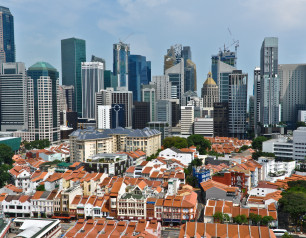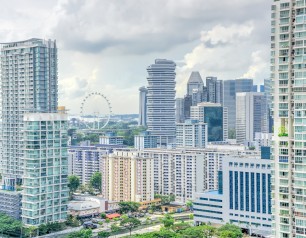Singapore's Rise to Prosperity
As stated by the BBC News, “Singapore is a wealthy city state in south-east Asia. Once a British colonial trading post, today it is a thriving global financial hub and described as one of Asia's economic ‘tigers’.” So, how did Singapore rise to such heights, from a small trading port before Raffles’ arrival, to the world’s largest port in the 20th century, and finally a place amongst the top-class countries?
Firstly, Singapore’s natural advantages. Singapore was situated along the Straits of Melaka/ Malacca, which connected the Indian Ocean and the South China Sea. Singapore was also located at the midpoint of the trade-route between Britain, India and Southern China, and hence Singapore was able to cater to global markets since she was easily accessible and could be reached by countries all around the world, who could stop over at Singapore to replenish their fuel and food supplies. Traders could also sell the goods they had with them in exchange for local produce such as gambier and pepper. As Singapore was situated between India and China, it allowed traders from two major empires at that time to dock and trade at Singapore instead of travelling further distances to each other’s ports for trade, which saved both time and resources. Merchant ships in the past had relied on the monsoon winds for travel to other countries and back home, and Singapore experienced monsoons at different times of the year. Between the months of June and September, the southwest monsoon would transport traders from countries west of the Indian Ocean to Singapore, and between October to February, the northeast monsoon would transport the traders back to their home. Likewise, the northeast monsoon had transported the traders from the South-China Sea to Singapore, and then back to their own countries through the southwest monsoon. Through middlemen (usually the Straits-born Chinese) stationed in Singapore, goods were collected and exchanged. Even after ships were modernised, running on fuel instead of wind, Singapore still held an advantage with a naturally deep harbour, which meant larger ships, which could carry more goods from all around the world could come to Singapore’s harbours to trade. This strategic location made Singapore the ideal location for trading, and when utilised properly, this advantage allowed Singapore to close the gap with her economic rivals and even overtake them. This was because with her naturally deep harbour and strategic location, Singapore would then become increasingly attractive to foreign investors and which ensures continued investment and our economic survival. In 1990, Singapore even grew to be the busiest port in the world.
Thus, Singapore’s natural advantage enabled her to trade with countries all around the world, giving her advantage over economic premises ensuring future advancements and progress in Singapore’s economy.
Next, Singapore had several capable leaders who were able to govern Singapore well. Many of them had the determination and passion to work tirelessly for Singapore’s future and as stated by Mr Lee Kuan Yew, first Prime Minister of Singapore, that the leaders “weigh all possible consequences before [they] make any move on the political chessboard”. The leaders rationalised every decision that they were going to make, thinking of the impacts and consequences. This allowed them to be able to consider all perspectives and think of the best action to make for Singapore. The leaders worked well together, uniting as one government to lead Singapore to prosperity. An example of great leadership was S.Rajaratnam, Deputy Prime Minister from 1980 to 1985. He was first chosen to be the Minister for Foreign Affairs as he was stated to be "friendly, urbane, sincere and had the balance between standing up for principles and the need for diplomatic compromise". He was a righteous man and advocated for the correct values. He drafted the National Pledge as a symbol of unity of the people and emphasized the multiracial nature of the state in an attempt to soothe the racial tensions in Singapore. Therefore, this allowed Singapore to stand at an advantage with good political leadership and adept ministers. With capable leaders taking charge of the nation, leading it with order and unity, Singapore would be able to progress to excellence. The leaders also worked diligently towards their goal financially, their aim for national identity and the country’s defense, to strengthen the fundamentals to build a strong nation. They gave Singapore a higher chance of survival as a tiny island-city after the separation with Malaysia.
After the separation with Malaysia, the former British colony was free to have a fresh start as an independent nation to develop herself into a new economic model.
After achieving independence on 9 August 1965, Singapore was no longer bound to any other country, and could finally make decisions for herself. The Singapore government would be able to implement policies for the country without any external influence or pressure from other governments. Even when Singapore had achieved internal self-government, it was still a British colony, and had to consult the British government in the areas of foreign affairs and defence. When Singapore merged with Malaysia, she was no longer under the British’s control, but the Singapore government still had to consult with Tunku Abdul Rahman and the Federation for certain aspects, usually social matters. After separation from Malaysia and gaining independence, all of Singapore’s matters, both legislative and executive, were to be decided by the locals of Singapore. Hence, without any conflicting beliefs from other ruling governments, Singapore was finally able to make her own decisions and the government could lead the country in their own way, making her in a position where she could succeed on her own terms without any oppressions. This new start gave Singapore the opportunity to develop a new economic model. The new economic model moved away from predominant Asian postcolonial protectionist models, but rather focused on attracting foreign investors like Multinational Corporations(MNCs) to set up companies in Singapore where they provide jobs for people and contribute to the economy in that way. For instance, the American Multinational Corporations brought in higher technology such as textile and toy manufacturing in large-scale operations, creating many jobs for the people in Singapore. MNCs could give workers employment and teach them new and advanced technical and engineering and management skills. Singapore was hence provided with much needed capital for rapid industrialization and necessary for the rapid creation of jobs for workers. In this way, people could contribute to the economy of Singapore and hence helped Singapore prosper.
In conclusion, through Singapore's natural advantages (monsoon winds- 20th century, deep harbour, geographical location between powerful trading businesses), the competency of Singapore’s leaders, and the fresh start independence gave her, Singapore was able to rise to prosperity from a humble fishing port to a renowned country all around the world.



